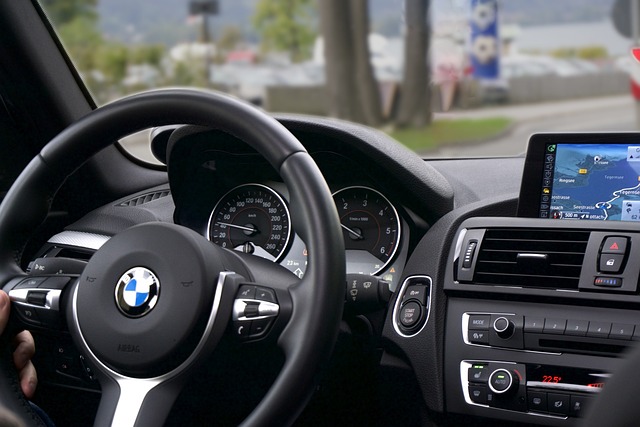Looking to register your car in California? This comprehensive guide breaks down the process step-by-step. First, understand the eligibility requirements for car registration in California, ensuring your vehicle meets state standards. Next, gather all necessary documents for a smooth DMV VIN verification. Prepare your vehicle for inspection and registration, then complete the official process at your local California DMV office. Finally, learn post-registration tasks like insurance, title transfer, and license plate acquisition.
- Understand Eligibility Requirements for Car Registration in California
- Gather Necessary Documents for DMV VIN Verification
- Prepare Your Vehicle for Inspection and Registration
- Complete the Registration Process at the California DMV
- Post-Registration Steps: Insurance, Title Transfer, and License Plate Acquisition
Understand Eligibility Requirements for Car Registration in California

Before registering your car in California, it’s crucial to understand the eligibility requirements set by the Department of Motor Vehicles (DMV). One key step is ensuring your vehicle meets all safety and emissions standards. A DMV VIN verification is typically required, which involves checking the vehicle identification number (VIN) against the manufacturer’s records to confirm its authenticity and history.
Additionally, you’ll need proof of insurance and a valid driver’s license. If you’re using a mobile vin verifier for inspection, make sure it’s from a trusted source, as this can streamline the process. Keep in mind that certain types of vehicles, like classic cars or those with modified engines, might have different registration requirements. Always refer to the DMV guidelines for accurate and up-to-date information tailored to your specific vehicle.
Gather Necessary Documents for DMV VIN Verification

Before heading to the DMV for car registration, ensure you have all the required documents, especially for the critical dmv vin verification process. This includes your vehicle’s registration certificate from the previous state (if applicable), proof of insurance, and a valid driver’s license. Additionally, gather important papers related to ownership, such as the title or bill of sale.
For a smoother process, consider arranging a mobile vin inspection or vin inspection by an authorized agent who can provide you with a digital report. This step is crucial for confirming your vehicle’s history and identifying any potential issues, ensuring a seamless registration experience in California.
Prepare Your Vehicle for Inspection and Registration

Before you can register your car in California, it’s essential to ensure that your vehicle meets all safety and emission standards set by the state. One crucial step is preparing for the DMV (Department of Motor Vehicles) vin verification process, which checks critical components like lights, brakes, horn, and emissions controls. Make sure all necessary parts are functioning properly and up-to-date with any required maintenance to pass inspection smoothly.
Additionally, consider using a mobile vin inspection or mobile vin verifier service to simplify the preparation process. These services offer on-site vehicle assessments, allowing you to address any issues before visiting the DMV. By ensuring your car is ready for vin verification, you’ll expedite the registration process and minimize potential delays.
Complete the Registration Process at the California DMV

After gathering all the necessary documents and ensuring your vehicle meets California’s requirements, it’s time to complete the registration process at the California Department of Motor Vehicles (DMV). Visit a local DMV office or utilize their online services for a smoother experience. The initial step involves providing detailed information about your vehicle, including its make, model, year, and unique Vehicle Identification Number (VIN). This VIN verification is a critical aspect of the process, ensuring that the vehicle matches the documentation accurately.
The DMV will conduct a thorough inspection, which may include a mobile VIN inspection or on-site verification to cross-check the details against their records. Once your vehicle passes this stage, you can proceed with selecting the appropriate registration package, paying the associated fees, and updating your personal information if necessary.
Post-Registration Steps: Insurance, Title Transfer, and License Plate Acquisition

After successfully registering your vehicle with the California DMV, there are several crucial post-registration steps to complete. The first and most essential is insuring your car. You’ll need to obtain a policy from an insurance provider approved by the state of California. This not only protects you financially in case of accidents or damages but is also mandatory for operating your vehicle legally on public roads.
Next, if you’re transferring ownership, you’ll need to conduct a title transfer through the DMV. This involves submitting the necessary paperwork and paying the required fees. Once approved, the new owner’s name will be added to the vehicle’s title. Additionally, you’ll require a license plate for your car, which can be obtained after the title transfer is complete. The process typically includes applying for a license plate through the DMV or an authorized agent, ensuring it aligns with California’s regulations and vehicle specifications. Remember, proper documentation, including proof of insurance and a valid title, is key to a smooth experience during these post-registration procedures.
Registering a car in California involves several straightforward steps. By understanding the eligibility requirements, gathering the necessary documents for DMV VIN verification, preparing your vehicle for inspection, and completing the registration process at the California DMV, you can ensure a smooth transition into California’s vehicular landscape. After registration, remember to obtain insurance, transfer the title, and acquire license plates as required by state regulations, ensuring compliance with all post-registration steps.
